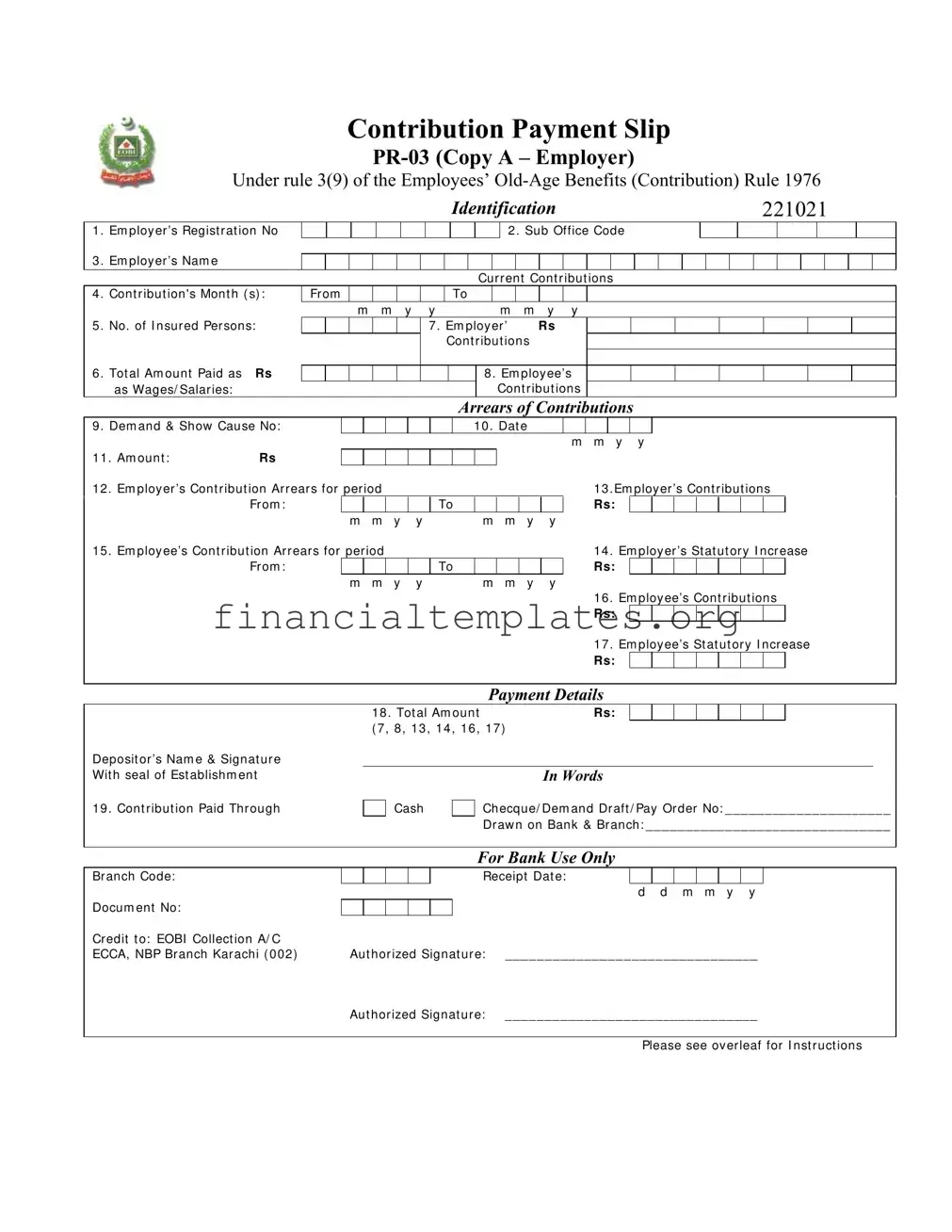The EOBI Contribution Payment Slip form shares similarities with the Federal Tax Deposit Coupon used in the United States. Both forms are used by employers to report and pay contributions or taxes due for their employees. The key similarity lies in their purpose: to ensure compliance with respective government regulations regarding employee benefits and taxation. Just as the EOBI slip outlines contributions to an old-age benefits scheme, the deposit coupon is crucial for reporting federal tax withholdings, including social security and Medicare taxes.
Another document resembling the EOBI slip is the State Unemployment Tax Act (SUTA) payment form, which employers use to report unemployment taxes at the state level in the U.S. Both forms concern employee benefits, though targeting different aspects. The EOBI slip focuses on old-age benefits, whereas SUTA addresses unemployment insurance. Employers fill out these forms based on wages paid and the number of employees, ensuring contributions are accurately reported and paid to support respective funds.
The Quarterly Federal Excise Tax Return, much like the EOBI Contribution Payment Slip, is a periodic tax document required for certain types of businesses in the U.S. that sell goods and services subject to excise taxes. Similarities include the need to report total amounts due for a specific period and the necessity of adherence to deadlines to avoid penalties. Although the EOBI slip deals with employee benefits and the excise tax return with sales-related taxes, both require detailed financial reporting for compliance purposes.
The Workers’ Compensation Insurance Premium Payment form, which companies use to report salary payouts and calculate insurance premiums, also echoes the EOBI Contribution Payment Slip. They both cater to employee welfare, with the EOBI slip focusing on retirement benefits and the workers' compensation form addressing workplace injury or illness. Each form helps employers fulfill their legal obligations toward employee safety and financial security.
The 401(k) Contribution Reporting form tracks employee contributions to a retirement savings plan, aligning with the EOBI slip's aim of ensuring future financial security for workers. Both documents involve calculating contributions based on salaries and maintaining records for compliance and audit purposes. While the EOBI form pertains to a government-mandated program, the 401(k) form relates to voluntary retirement savings plans in the private sector.
Form W-2, Wage and Tax Statement, in the United States, requires employers to report wages paid and taxes withheld for each employee annually. It parallels the EOBI slip in that both provide critical information for government records concerning employee earnings and contributions. The EOBI form deals with specific contributions to a pension fund, whereas Form W-2 encompasses broader tax reporting including income, social security, and Medicare taxes.
The Payroll Tax Remittance form, used for reporting and paying employer payroll taxes in many jurisdictions, has a similar function to the EOBI slip. Both serve to collect and remit funds to government agencies — the EOBI slip for employee benefit contributions and the payroll form for income and employment taxes. Accurate calculation and timely payment are essential features of both forms to ensure compliance and avoid penalties.
The Annual Return of Withheld Federal Income Tax form, or Form 945 in the U.S., is used to report withheld federal income tax from non-wage sources. This form, while primarily focused on taxation rather than employee benefits, shares the EOBI slip's purpose of reporting to governmental authorities. Each form plays a key role in the financial infrastructure that supports social welfare and compliance with tax laws.
The Health Insurance Premium Payment form, utilized by employers to report and pay premiums for employee health insurance, bears resemblance to the EOBI slip. Both involve financial contributions critical to the wellbeing of employees — the EOBI slip for retirement benefits and the insurance payment form for healthcare coverage. Monitoring and reporting these payments help to ensure that employees receive their benefits as entitled.
Lastly, the Employee Stock Ownership Plan (ESOP) Contribution form mirrors the EOBI slip in its purpose of ensuring future financial welfare for employees. While the EOBI slip secures funds for old-age benefits, the ESOP form facilitates employee investment in the company. Both require detailed reporting of financial contributions, demonstrating an employer's investment in the long-term financial health of their employees.




